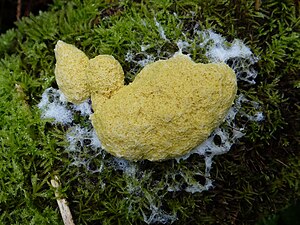Yellow tan blossom
| Yellow tan blossom | ||||||||||||
|---|---|---|---|---|---|---|---|---|---|---|---|---|

Fuligo septica |
||||||||||||
| Systematics | ||||||||||||
|
||||||||||||
| Scientific name | ||||||||||||
| Fuligo septica | ||||||||||||
| ( L. ) FHWiggers |
The yellow tan blossom or witch butter ( Fuligo septica ) is a species of slime mold from the order of the Physarida . It is common, widespread, and usually of a striking yellow color.
features
The plasmodium is usually yellow, less often white or cream-colored. The fruit bodies ( aethalia ), which usually occur individually, rarely in small groups, have a diameter of 2 to 20 centimeters and a height of up to 3 centimeters. They are white to light yellow, pale pink to red, dark red, brown, purple or greenish. The hypothallus consists of one or more layers of colorless to brownish, perforated membranes that do not protrude beyond the aethalium . The outer skin of the aethalium ( cortex ) is relatively thick, calcareous and fragile, rarely firm or completely absent, the membranous peridium is colorless and has scattered calcareous spots.
The occasionally only weakly developed scalp is physaroid, i.e. it forms a network in which thickened, irregularly shaped, reddish or yellow to white calcareous nodes are connected by slender, translucent and calcareous-free threads.
The six to nine micrometers in diameter, smooth to finely prickly, spherical spores are dark gray to black in mass, and individually bright purple in transmitted light.
Distribution and ecology
The yellow tan blossom is widespread worldwide. It colonizes rotting wood, bark, rotting material in the litter horizon of the forest floor and the soil itself. Occasionally, fruiting bodies are also formed on living plants, but the plants are not damaged. Sometimes the plasmodia can also be found on lawn. Evidence also exists for deserts.
A fungus that specializes in the ethers of the species, especially at higher latitudes, is the tubular fungus Nectriopsis violacea . Beetles of the moss mold beetle family (Lathridiidae) also feed on the ethers, but at the same time spread the spores.
Systematics
Fuligo septica was first described by Carl von Linné in 1763 as Mucor septicus , in 1780 Friedrich Heinrich Wiggers placed it in the genus Fuligo , of which it is a type . A holotype is not given in the first description, locus classicus is France.
use
Plasmodia of the yellow tan blossom are grilled or fried in the Veracruz area in Mexico and consumed as a delicacy as “caca de luna” (“moon poop”).
proof
- ^ A b c Marie L. Farr: Myxomycetes . In: Flora Neotropica . tape 16 . The New York Botanical Garden, New York 1976, ISBN 0-89327-009-1 , pp. 93-94 .
- ^ A b Henry Stempen, Steven L. Stevenson: Myxomycetes. A Handbook of Slime Molds . Timber Press, 1994, ISBN 0-88192-439-3 , pp. 123-124 .
- ^ Henry Stempen, Steven L. Stevenson: Myxomycetes. A Handbook of Slime Molds . Timber Press, 1994, ISBN 0-88192-439-3 , pp. 54 .
- ↑ M. Blackwell, TG Laman: Spore dispersal of Fuligo septica (Myxomycetes) by lathridiid beetles. In: Mycotaxon 14, 1, pp. 58-60, 1982
- ^ A b Henry Stempen, Steven L. Stevenson: Myxomycetes. A Handbook of Slime Molds . Timber Press, 1994, ISBN 0-88192-439-3 , pp. 66-68 .
- ↑ Anubha Parhak, Sharda Vaidya: Slime Molds: The Tiny Charmers . In: Fungi and their Role in Sustainable Development: Current Perspectives. Praveen Gehlot, Joginder Singh, accessed July 2, 2020 . , Springer eds., Parapraph 5.5.11., P. 86


